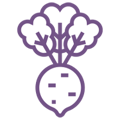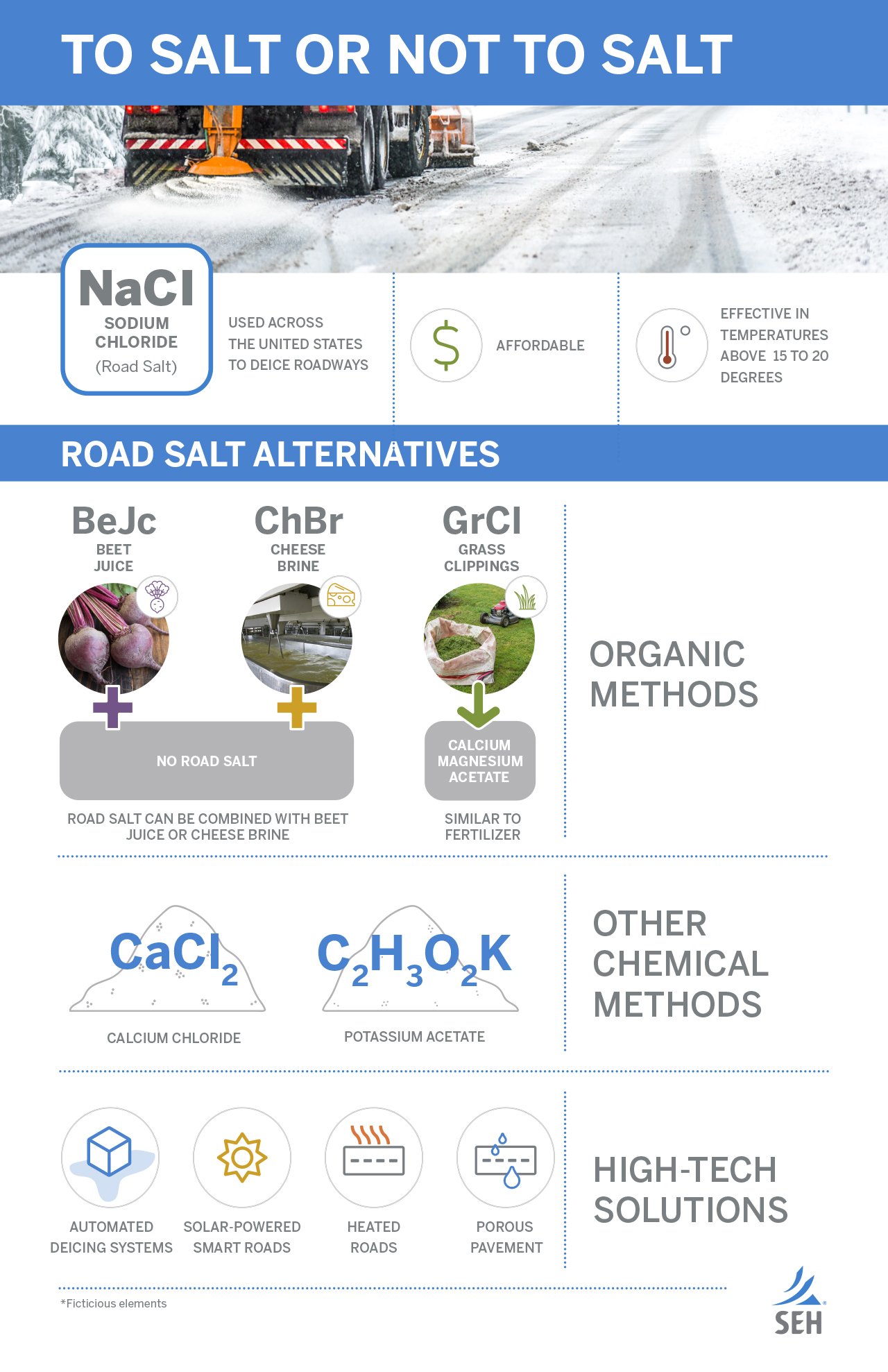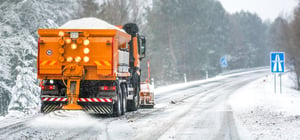Road salt has been used to combat icy roads for decades. Over the years, application techniques and storage methods have changed. There is also growing concern of the harmful impact road salt has on waterways. But, are there other ways to keep drivers safe in the winter?

When Mother Nature serves up cold, snow and ice, municipalities and DOTs across the United States turn to sodium chloride to deice their roadways. This compound is very similar to common table salt, albeit a much coarser version. It’s an affordable, effective means to remove snow and ice from our roads—keeping people safe. However, the compound is only effective in temps above 15 or 20 degrees and can potentially impair our waterways. So, what other options are available to protect our waterways and sustain our resources—while maintaining safe roads? Turns out, there are a lot of alternatives.
What are the alternatives?
There are quite a few options to prevent snow and ice build-up on our roads, some more common than others. Here are some of those methods.
Organic methods

Beet juice
The briny wastewater left over after processing sugar beets can be used on roadways to dissolve ice. The sugar in the wastewater lowers the melting point of ice, making it easier to remove. Beet juice can also be combined with rock salt, helping the salt better stick to roadways. A downside is that the excess sugar in the environment can cause bacterial growth. There’s another problem. It smells. In communities where this method was tested, residents said it smelled like soy sauce. When the juice is combined with salt it produces a sticky substance that people didn’t like.

Cheese brine
Some Wisconsin communities have been experimenting using cheese brine to deice roads. The brine is a byproduct created during cheese production. Like beet juice it can help salt stick to the roadway. It also has a lower freezing point than regular salt water. Polk County in western Wisconsin conducted a study and found that when using cheese brine combined with road salt, it reduced salt use by 30 to 40 percent. Typically, manufacturers have to pay to get rid of this brine. But, partnering with DOTs could be a mutually beneficial relationship.

Grass clippings
Organic waste like grass clippings and food garbage can ferment into calcium magnesium acetate. The compound is similar to fertilizer and can be extremely effective removing ice from roads. The problem is, it is costly to properly remove enough of the acetate from the compound to make it effective. Plus, the fertilizer-like product is known to have worse environmental effects than using road salt.

Pickle brine and potato juice
Pickle brine and potato juice have also been used to deice roads. The two liquids act similarly to cheese brine and beet juice.
Other Chemical methods

Calcium chloride
Calcium chloride can melt snow quicker and at a lower temperature than salt, but can damage roadways, vehicles and more. Long-term winter applications also increase impact waterways due to calcium chloride entering groundwater. What’s more, is calcium chloride melts snow and ice so quickly it leaves behind lots of moisture. This leftover moisture can then refreeze if it’s cold enough.

Potassium acetate
Potassium acetate can be applied before a snow or ice event to prevent sticking to the pavement. Fewer applications are required as it continues to work longer than other pretreatment methods. The problem is it can lower oxygen levels in waterways and do damage over time.
Calcium chloride and potassium acetate are also more expensive than sodium chloride (road salt).
Although some of these alternatives are effective in deicing roads, they’re just not as economical and plentiful as salt. And, there is limited infrastructure in place to support these alternative methods.
“If we think about road salt and how long we’ve been using it,” says Brad Woznak, SEH water resources engineer, “there is a whole infrastructure built to support it.”
How would a new deicing agent get to communities? How would it be stored? Where would it be stored? Answering these questions would surely come with their own costs. It’s partly because of these economic factors that Woznak says more communities don’t explore alternatives to road salt.
High-tech solutions
Of course, road salt, brines and chemicals aren’t the only means to rid our roadways of snow and ice. There are a number of other high-tech solutions that will do the job as well.

Automated deicing systems
These systems help bridge decks from becoming caked in ice. The systems use sensors about the size of a hockey puck to monitor bridge conditions. They sense if the bridge is wet or dry, pavement temperature, and if there is frost or ice on the roadway. The sensors communicate with a small weather station at one end of the bridge. If the conditions warrant, sprayers mounted within the roadway spread a liquid chemical that helps prevent freezing. A computer tells the system exactly how much of the chemical is needed, based upon the weather event happening. For example, more liquid is needed during snow, and less for frost events.

Solar-powered smart roads
Although more of a concept, these roadways would be made from strong glass solar panels. The panels would absorb the sun’s energy, transferring it to embedded heating elements within the road. The design is similar to how a car’s rear window has heating elements built in to melt snow and ice. Excess energy in the summer could be harnessed for other uses.

Heated roads
Circulated hot water beneath a street is one way snow-heavy cities in Japan have tackled snow melt. Instead of the roadway made of solar panels, the panels are located along the road. The energy developed by the solar panels heats water that travels through pipes beneath the roads. Cities like Vail and Aspen, Colorado, are using similar technology to heat their sidewalks and roadways to melt snow and ice away. Although very effective, this method comes with an obvious cost deterrent for most cities.
Target Field Station in Minneapolis, Minnesota uses an antifreeze mixture pumped through 50 miles of tubing embedded under the walkway. The system melts snow without the use of deicing agents.

Porous pavement
Contrary to what one may think, this technology can also help prevent ice build-up on roadways. These pavements are not adversely affected by freezing. In cold climates, the surface remains porous, with water able to reach beneath the subbase. Still, salting is required to melt snow and ice from the surface. However, porous pavement comes with steep maintenance costs, and concrete systems have demonstrated weakening and spalling when combined with salt application.
With all of these technological and chemical methods of clearing snow and ice, it may help to take a step back and examine how we’re using what we have.
Using salt responsibly
By smartly reducing the amount of salt on roadways, and combining it with some of the brines mentioned earlier, we can continue to have successful results reducing snow and ice. Municipalities and DOTs are using electronic spreading systems on their trucks to intelligently deliver just the right amount of salt to roads and parking lots. They are timing their salt applications better and using less salt overall.

Bringing it all together
Road salt has been the mainstay in fighting the battle of roadway snow and ice for decades, but new technologies have shown promise. As we progress into the future, it’s important to pay attention to potential environmental impacts as we evaluate our current methods and look for new technologies that can help us along the way.
About the Expert

Brad Woznak, PE, is a water resources engineer dedicated to environmentally-sound, smart solutions.

.png?width=113&name=SEH_Logo_RGB%20(1).png)
